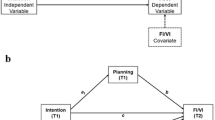Abstract
A major national health campaign has recently been initiated to promote consumption of 5 or more servings of fruits and vegetables each day. This paper investigates psychosocial factors related to fruit and vegetable consumption to understand better who might be receptive and who might resist the national 5-A-Day campaign. We studied 405 adult respondents to a random-digit dial telephone survey. Applying the Transtheoretical Model, respondents were classified by stage of readiness to adopt the practice of eating 5 or more fruits and vegetables each day. Logistic regression models were developed for persons consuming 2 or fewer servings daily and for persons in the Precontemplation stage. Education was directly related to fruit and vegetable intake and indirectly related to being in the Precontemplation stage. Males were twice as likely as females to be in the Precontemplation stage and eat fewer than 2 servings a day. Of special interest, respondents with children at home were at greater risk of eating 2 or fewer servings a day than those without children at home (OR=1.63; 95% CI, 1.06–2.52). These results imply that stage of readiness to change should be considered as well as other factors in planning interventions for increasing fruit and vegetable consumption.
Similar content being viewed by others
References
Anderson, S. A. (1992).Guidelines for Use of Dietary Intake Data, Life Sciences Research Office, Federation of American Societies for Experimental Biology; Bethesda, MD.
Block, G., Patterson, B., and Subar, A. (1992). Fruit, vegetables, and cancer prevention: A review of the epidemiologic evidence.Nutr. Cancer 18: 1–29.
Bunch, K. L. (1990).1989 California Dietary Practices Survey, Focus on Fruits and Vegetables, Highlights, Nutrition and Cancer Prevention Program, California Department of Health Services, California Public Health Foundation. Nutrition and Cancer Prevention Program, Sacramento.
Contento, I. R. (1992). Nutritional perspective on individual subject interventions. In Henderson, M. M., Bowen, D. J., and De Roos, K. K. (eds.),Promoting Dietary Change in Communities: Applying Existing Models of Dietary Change to Population Based Interventions, Fred Hutchinson Cancer Research Center, Seattle, WA.
Curry, S. J., Kristal, A. R., and Bowen, D. F. (1992). An application of the stage model of behavior change to dietary fat reduction.Health Educ. Res. 7: 97–105.
DiClemente, C. C., Prochaska, J. O., Fairhurst, S., Velicer, W. F., Velasquez, M. M., and Rossi, J. S. (1991). The process of smoking cessation: An analysis of precontemplation, contemplation and preparation stages of change.J. Consult. Clin. Psychol. 59: 295–304.
Dixon, W. J., Brown, M. B., Engelman, L., and Jennrich, R. I. (1990).BMDP Statistical Software, Vols. 1 and 2, Berkeley, University of California Press.
Ershoff, D. H., Mullen, P. D., and Quinn, V. P. (1989). A randomized trial of serialized self-help smoking cessation program for pregnant women in an HMO.Am J. Public Health 79(2): 182–187.
Greene, G., Rossi, S., Reville, A., Reed, G., and Blais, L. (1992).Evaluation of an Individualized Feedback System for Reduction of Dietary Fat Intake, Society for Nutritional Education, Washington, DC, July.
Hosmer, D. W., and Lemeshow, S. (1989).Applied Logistic Regression, John Wiley & Sons, New York.
Kristal, A. R., Abrams, B. F., Thornquist, M. D., and Disogra, L., et al. (1990). Development and validation of a food use checklist for evaluation of community nutrition interventions.Am. J. Public Health 80: 1318–1322.
National Institutes of Health (1985).Health Implications of Obesity: Consensus Development Conference Statement, Bethesda, Feb. 11–13.
Ockene, J., Kristeller, J. L., Goldberg, R., et al. (1992). Smoking cessation and severity of disease: The Coronary Artery Smoking Intervention Study.Health Psychol. 11: 119–126.
Patterson, B. H., Block, G., Rosenberger, W. F., Pee, and Kahle, L. L. (1990). Fruits and vegetables in the American diet: Data from the NHANES survey.Am. J. Public Health 80: 1443–1449.
Prochaska, J. O., and DiClemente, C. C. (1983). Stages and processes of self-change of smoking: Toward an integrative model of change.J. Consult. Clin. Psychol. 51: 390–395.
Prochaska, J. O., and DiClemente, C. C., (1986). Towards a comprehensive model of change. In Miller, W., and Heather, N. (eds.),Treating Addictive Behaviors, Plenum Press, New York, pp. 3–27.
Prochaska, J. O., DiClemente, C. C., and Norrcross, J. C. (1992). In search of how people change: Applications to addictive behaviors,Am. Psychol. 47(9): 1102–1114.
Prochaska, J. O., DiClemente, C. C., Velicer, W. F., and Rossi, J. S. (1993). Standardized, individualized, interactive and personalized self-help programs for smoking cessation.Health Psychol. 12(5): 399–405.
Prochaska, J. O., Velicer, W. F., Rossi, J. S., Goldstein, M. G., Marcus, B. H., Rakowski, W., Fiore, C., Harlow, L. L., Redding, C. A., Rosenbloom, D., and Rossi, S. R. (1994). Stages of change and decisional balance for twelve problem behaviors.Health Psychol. 13(1): 39–46.
Rossi, J. S. (1992). Stages of change for 15 health risk behaviors in an HMO population. Paper presented at the 13th annual scientific sessions of the Society of Behavioral Medicine, New York, March.
Salmon, C. T., and Nichols, J. S. (1983). The next-birthday method of respondent selection.Public Opin. Q. 47: 207–276.
Subar, A. S., Heimendinger, J., Krebs-Smith, S. M., Patterson, B. H., Kessler, R., and Pivonka, E. (1990).5-A-Day for Better Health. A Baseline Study of American's Fruit and Vegetable Consumption, National Cancer Institute, National Institutes of Health, Rockville, MD.
U. S. Department of Health and Human Services (1991).Health People 2000: National Health Promotion and Disease Prevention Objectives, DHHS Publ. No. (PHS) 91-50212. U.S. Government Printing Office, Washington, DC.
Willett, W. (1990). Vitamin A and lung cancer.Nutr. Rev. 48: 201–211.
Ziegler, R. G. (1991). Vegetables, fruits, and carotenoids and the risk of cancer.Am. J. Clin. Nutr. Suppl. 53: 251S-259S.
Author information
Authors and Affiliations
Rights and permissions
About this article
Cite this article
Laforge, R.G., Greene, G.W. & Prochaska, J.O. Psychosocial factors influencing low fruit and vegetable consumption. J Behav Med 17, 361–374 (1994). https://doi.org/10.1007/BF01858008
Accepted:
Issue Date:
DOI: https://doi.org/10.1007/BF01858008




